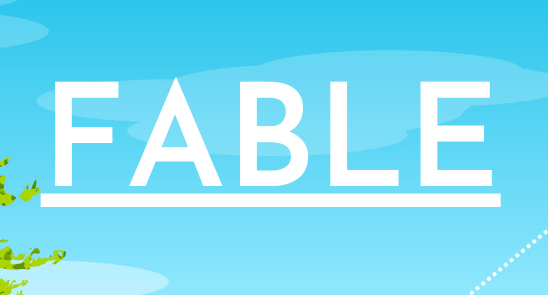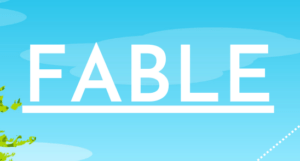A storytelling game by Kyle Nguyen and Yuchen Wang 📖
Download Fable here!
We made Fable because we believe stories are a crucial part of how humans make sense of the world. From interviewing for a dream job to going on a coffee date in a new city to pitching a business idea, we are constantly telling using narrative to understand ourselves and others. However, many people do not understand the crucial elements of stories, nor do they have the practice of expressing a narrative coherently. Enter Fable, a storytelling game for all ages (8+), developed with college-age playtesters.* In Fable, 2–4 players use random “Traits,” “Motivations,” “Conflicts,” and more to craft a story collaboratively.
Fable’s learning outcomes are that players will gain familiarity with structuring coherent narratives, understand the crucial elements of a story, and increase their creativity and verbal expression skills. We will measure them via qualitative data through observations of playtests, watching for an improvement in players’ creative expression and players’ comfort in crafting a narrative using the traditional elements (character, motivation, conflict, setting, etc.)
*We originally wanted Fable to be for kids! This is now a Future Step.
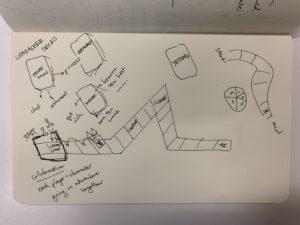
This is the back-of-the-napkin sketch where we came up with the idea for Fable!

Fable focuses on these kinds of fun: expression, narrative, fellowship, and fantasy. Narrative and fantasy are naturally part of a storytelling game. Expression and fellowship were deliberate decisions we made when designing the game.
Expression
We designed Fable to be as open-ended as possible. We took the approach of starting with radical creative freedom and only adding constraints when playtests indicated players needed more guidance. One example was the modifications we made to the “Motivation” card, a constraint that we added after we discovered players forgot about the motivation in Playtest 3. This encourages the expression type of fun!
Fellowship
We designed Fable as a collaborative game to create a positive, encouraging environment (avoiding “Killers!”), which serves our learning outcome of Increasing players’ creative expression. By giving all the players a common “Motivation,” we create a bonding experience between players, who are united by a superordinate goal.

When designing Fable, we considered Tracy Fullerton’s 7 Formal Elements of Games in these categories.
Players & Resources (Characters)
Fable is played by 2-4 players. Each player has a “Profession” and “Trait” card, which serve as their Resources for the duration of the game—they have to use their creativity to use these cards to navigate through the game/story!
Objective, Conflicts, & Boundaries (Conflicts and Climax)
The objective of the game is to successfully complete the “Motivation,” which has a series of steps that must be creatively solved by players. Each player draws a “Conflict” on their way towards this goal which they have to overcome. The boundaries of Fable are only limited to the players’ imagination, though they have to stay true to the character. The shared “Motivation” ensures players stay on track with a coherent story. At the “Climax,” all players band together to overcome the final “big boss” conflict.
Outcomes (Resolution)
At the end of the game, players have created an entire story! There is no losing outcome for Fable. Your success is only defined by how much you enjoyed the story. A “Resolution” card allows players to tie up any loose ends.
Rules & Procedures
The game proceeds such that each player gets to be the star of the show at least once, on their own “Conflict” card. In responding to the conflict, players must progress the story to the next motivation stage. For extended rules, see the Rules sheet in the print-out version of Fable!

We’ve recorded the design iterations we’ve made on Fable, incorporating player feedback on the way.
Playtest 1 in-class 1/19
We playtested “Fable” for the first time with three classmates during studio 2B. The playtest and the discussion lasted 10 minutes each. The test ran smoothly and people gave us highly positive feedback regarding the design and game dynamics.
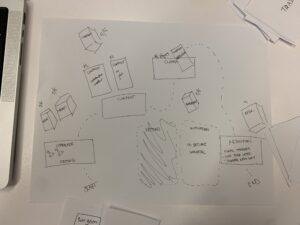
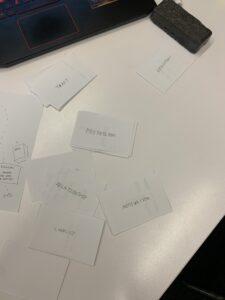
Sketch of playing board (left) and cards (right) for Fable V1.
Who are you playtesting on?
- 3 Stanford students from CS 377G (college-age), all female
Things to keep
- Players love how this makes them creative.
- Players love to see their unique combinations of traits and professions because they are funny.
- Players loved the creative freedom within the game’s boundaries
- Didn’t feel overly restricted by the rule that you must refer to your profession/trait at least once per conflict (something we were concerned about)
- They like that the traits/professions were still simple enough to allow them to improvise freely.
- Players love the conflicts(hints) that drive the story so that they don’t have to come up with a story out of nowhere.
Things to change
- Instead of a relationship between every pair of characters, the players will have a universal relationship (friends, strangers, enemies…) since players found the pairwise relationships too complex to manage.
- Modify the “1 year later” resolution card to “1 month later”; we want to encourage players to create a resolution with continuity to the story, and one year wasn’t soon enough.
- Change player cap to four (worked smoothly enough with three players to add one more!)
- Add pictures to the professions to make it more educational
Notes
- The game lasted ~10 minutes (3 players); we were concerned it might end too quickly but turns out not to be the case since players enjoy storytelling naturally.
- Sometimes players forgot about overarching motivation; writing this as a note-to-self, if this continues for future players, we suggest enforcing that the motivation must be referred to in each conflict resolution.
Playtest 2 with outsiders 1/23
We polished our prototype significantly for our second playtest. This is Fable V2.
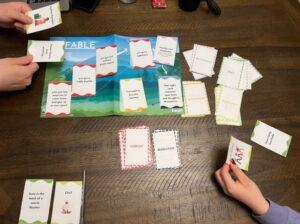
Who are you playtesting on?
- My friends at Stanford (adults, unfortunately)
- Female, aged 23, MSCS
- Male, aged 25, EE PhD
What went well?
- The users like that the game sparks their imagination.
- The users like that the game is anti-stereotype with different combinations of traits and professions.
What didn’t?
- The users pointed out that some cards appeared to be confusing
- Does the conflict apply to only one character or all characters?
- Provide more information or tweak in the resolution phase (e.g., to professions)
- The users didn’t like that the conflicts seemed detached from one another.
Changes
- Removed a resolution card that seems too confusing
- Changed the prompt on a misleading resolution card (assumes friendship among characters)
- Removed the pairwise relationship in favor of a universal relationship, changing the game to 2–4 players
Playtest 3 in-class 1/24
Who are you playtesting on?
- 4 students from CS 377G (college-age), 3 males, 1 female
What went well?
- The relationship card “changed everything” (in the word of a player)
- The universal relationship was a lot easier to play than pairwise relationships
- Players are very emotionally engaged when interacting with each other in a scene
- Players love to see new conflicts; when a new conflict is revealed, they are all on the edge of their seats
- Four players seemed to be a sweet spot for complexity
What didn’t go well?
- Players who are less comfortable being creative can get stuck (“Uh… I don’t know what to say.”)
- Players forget about the motivation, hyper-focusing on the conflict without regard to the overarching story.
- Set-up is a little complex, and players have to do a lot before the game begins and get a little bored.
Changes
- Added a hint spinner that players can use to “bail out” if they’re stuck
- Added steps to the motivations, so each conflict has to resolve a step, bringing players close to achieving the motivation
Playtest 4 in-class 1/26
Playtesters liked the addition of a hint spinner and motivation stages in Fable V3.
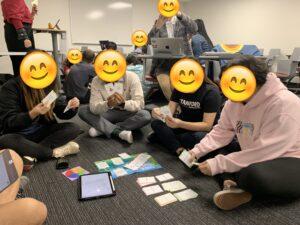
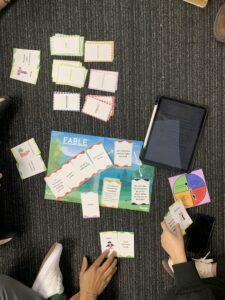
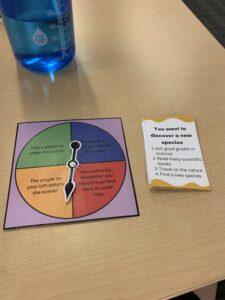
Observations and Feedback
- Players forgot to mention the motivation in the introduction round
- Players had to refer to the rules during the game multiple times
- Players want a clear signal of time to move on (maybe different levels of conflicts)
- The hints on the spinner are not clear enough

- Can players understand the rules and run the game smoothly?
- Can players achieve the types of fun as expected?
- Can players gain learning outcomes as expected?
During the four playtests, we observed the game dynamics and how the players interact with each other. After the gameplay, we asked players what they liked and what needed to be changed.
Can players understand the rules and run the game smoothly?
Playtest 4 demonstrated that this goal was achieved. It took new players around 5 minutes to understand the rules and the flow, and they had to refer to the rules several times during the first play. However, once the second player started drawing a conflict card, the flow became straightforward and they could run the game smoothly.
Can players achieve the types of fun as expected?
The collaborative nature of the game was demonstrated by players willing to help each other out and pick up others’ stories. Out of 13 players (double-counting people who played multiple times), ten loved that they could express their imaginations freely, given enough hints but little constraints. People loved to pick unique and humorous combinations of professions and traits and always came up with new jokes about them, which brought lots of laughter and fun during the storytelling process.
Can players gain learning outcomes as expected?
Playtest 4, which contains two gameplays, demonstrated that players gained expression skills and familiarity with structuring narratives since each player needed much less thinking time to form their language in the second play than in the first one. This demonstrates that repeated plays of Fable can be even more beneficial to learning. People came up with diverse stories and endings each time we test, and they immensely enjoyed that they could apply their creativity through structured verbal expressions.

The future modifications we’d make to Fable depend on our target audience.
The original idea for Fable was to create a storytelling game for young kids, and we think this is the most interesting future direction for the game. We have researched children’s writing and education and believe children aged 6–9 could benefit from a game like this. Similar games for children like Rory’s Story Cubes, Storymatic Kids!, and PBS Kids Storytelling Games inspire creativity but neglect to teach kids about narrative structure. We believe Fable could fill that gap.
To develop Fable for a younger audience, we would love to have younger playtesters try it out. Our primary concern in doing so is the complexity of the game, which has a lot of moving parts that children may not be able to keep track of. We suggest Fable be played with at least one adult who can keep the game on track. This makes sense for a classroom setting, which is where we imagine Fable being played.
If we were to continue developing Fable for an older audience, we would incorporate feedback from our college-age playtesters. We were already having players ask for more complexity. For example, they’d like more complex plot devices like foreshadowing or more difficult conflicts to traverse. We can imagine “retheming” Fable in a million ways (similar to Flux!), e.g., we could have a “Stanford Edition” of Fable that has Stanford-themed characters, conflicts, and motivations. Aged-up versions of Fable could give adults who enjoy storytelling a new fun party game.
Fable, it was a blast to tell your story! Thanks for reading 📖🥰


